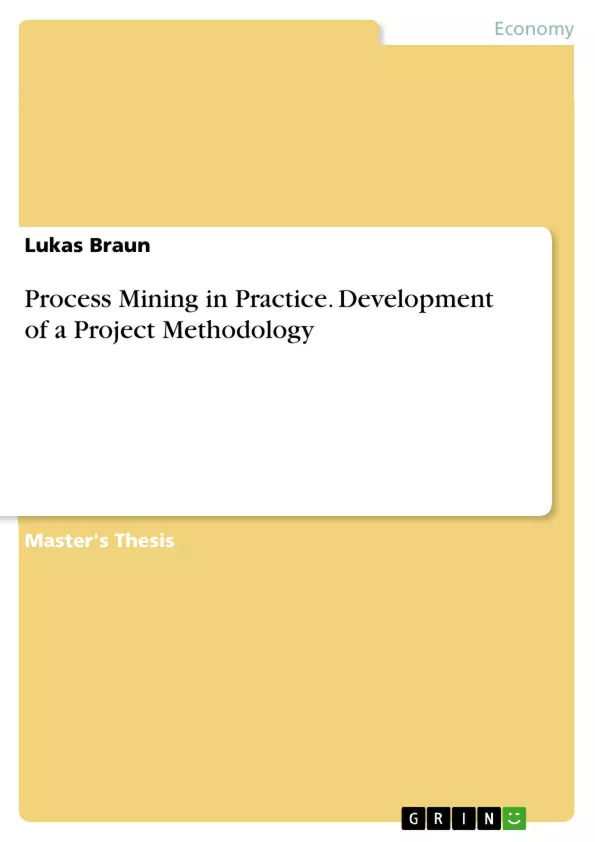Process Mining uses data to discover, monitor, and improve ongoing processes running inside organizations. Even though the relatively novel research discipline has matured theoretically, its practical application was treated with restraint by companies and lacks methodological thoroughness to this day. In order to diminish these shortcomings, this thesis aims to develop a process mining project methodology, which guides organizations through the implementation of process mining projects in practice. This work was developed using the Design Science Research Methodology (DSRM) and is based on both a theoretical and practical foundation. To this end, preexisting theoretical methodologies and fundamental literature were instrumented to build the methodology’s rough framework.
Subsequently, a case study analysis enabled the incorporation of further details about specific tools, techniques, and roles typically employed in practical process mining applications. This way, the methodology obtains a deep level of detail, is geared to practical applicability in several economic sectors, and facilitates the entry into the field for beginners. Ultimately, a significant number of domain experts evaluated the methodology in an online survey format, allowing for further improvement of its design and validity.
Inhaltsverzeichnis (Table of Contents)
- Introduction
- Problem Identification
- Objectives of this Work
- Research Structure
- Theoretical Background
- Business Process Management
- Data Mining
- Process Mining
- Types and Perspectives
- Tools and Algorithms
- Research Design
- The Research Design
- The Design Science Research Methodology
- The adapted DSRM
- The Artifact
- Attributes
- Elements
- Requirements of a Methodology
- Best Practices
- Challenges
- User Expectations
- Development of the Preliminary Design
- Analysis of existing Methodologies
- Similarities and Differences
- Drawbacks
- Development of the preliminary Methodology
- Practical Refinement
- Case Study Analysis
- Literature Review
- Template and Case Study Analysis
- Findings of the Case Studies
- Learnings and Limitations of the Case Studies
- Evaluation
- Evaluation Criteria and Design
- Content and Assessment
- Results and Adjustment
- Development of the Final Design
- Process Model
- Stages of the Final Methodology
- Project Set-up
- Data Extraction
- Event Log Improvement
- Process Mining
- Evaluation and Interpretation
- Value Creation
- Discussion and Conclusion
- Summary of the Approach
- Achievements
- Limitations
- Recommendations for Future Work
- General Conclusion
Zielsetzung und Themenschwerpunkte (Objectives and Key Themes)
This Master's Thesis aims to develop a process mining project methodology that guides organizations through the practical implementation of such projects. The methodology is based on both theoretical and practical foundations, leveraging existing methodologies and incorporating insights from case studies. The work aims to address the lack of methodological thoroughness in process mining projects and facilitate its practical adoption.
- Development of a process mining project methodology
- Bridging the gap between theoretical research and practical application
- Facilitating the implementation of process mining projects
- Analysis of existing process mining methodologies
- Practical refinement and evaluation through case studies
Zusammenfassung der Kapitel (Chapter Summaries)
- Introduction: This chapter introduces the thesis topic, highlighting the problem of limited practical application of process mining and the need for a methodological framework. It outlines the research objectives and structure.
- Theoretical Background: This chapter provides a comprehensive review of key theoretical concepts, including business process management, data mining, and process mining, laying the foundation for the development of the methodology.
- Research Design: This chapter outlines the research design, explaining the use of the Design Science Research Methodology (DSRM) to guide the development of the process mining methodology. It defines the characteristics and elements of the artifact, focusing on its practical applicability.
- Requirements of a Methodology: This chapter discusses the essential requirements of a process mining methodology, highlighting best practices, challenges, and user expectations.
- Development of the Preliminary Design: This chapter analyzes existing process mining methodologies, identifying their strengths, weaknesses, and potential drawbacks. It then presents the development of a preliminary methodology based on the analysis.
- Practical Refinement: This chapter focuses on refining the methodology through practical case studies. It explores the analysis of case studies and the resulting learnings and limitations.
- Evaluation: This chapter describes the evaluation process of the methodology, including the criteria used, the design of the evaluation, and the results of the evaluation.
- Development of the Final Design: This chapter presents the final design of the process mining methodology, including its process model and stages. It details the steps involved in project setup, data extraction, event log improvement, process mining, evaluation and interpretation, and value creation.
Schlüsselwörter (Keywords)
The core keywords of this thesis include process mining, project methodology, Design Science Research Methodology (DSRM), practical application, case studies, data extraction, event log improvement, process analysis, evaluation, and value creation.
- Quote paper
- Lukas Braun (Author), 2020, Process Mining in Practice. Development of a Project Methodology, Munich, GRIN Verlag, https://www.grin.com/document/1266611



